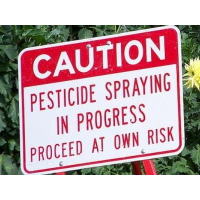Days after Lawmakers Reject Bill on Pesticide Use Near Schools, Study IDs 118,000 Students at Highest Risk
 (photo: Science Daily)
(photo: Science Daily)
The executive summary of a new state study (pdf) leads with the good news: “Most schools did not have any pesticides of public health concern applied nearby.”
The bad news: 36% of the 2,511 schools in 15 California counties with the highest use of “pesticides of public concern” were within one-quarter mile of the dangerous chemicals. Children are particularly sensitive to the dangerous health effects of pesticides, which are often applied in a fashion that allows them to drift in the wind far from their application.
The study by the California Department of Public Health (CDPH) emphasizes that the state did not measure how many children were actually exposed to pesticides or link pesticides to their health.
The survey did find that more than 118,000 students attend schools close to the heaviest use of pesticides. More than 140 of the most dangerous pesticides—linked to cancer, reproductive problems and nervous system damage—are used close to schools. Fumigants that drift in the wind comprise the top five pesticides applied.
Most of the counties surveyed were in the Central Valley. Tulare County had the highest percentage of schools close to pesticides (63.4%), followed by Merced (61.2%), Stanislaus (51.4%), San Joaquin (47.5%), Monterey (46.7%), Santa Barbara (45.4%) and Madera (42.5). Fresno County had the most schools at risk, 131 out of 899 identified in the survey, followed by Tulare (123) and San Joaquin (106).
The distribution of pesticides at schools in the counties studied was not consistent. A small percentage of schools were near farms where enormous amounts of pesticides were used. Ventura County had the highest number of schools (12) and students (13,045) is the 5% of schools near the largest pesticide usage.
Not surprisingly, Latino children are the most heavily impacted ethnic group by far. They are 46% more likely to attend schools near pesticide-laden fields than white students, but 91% more likely “to attend a school in the top quartile of pesticide use compared to children attending schools with no pesticide use nearby.”
The report comes just days after the state Senate Agriculture Committee killed a measure that would have required schools within a quarter-mile of pesticide spraying be notified in writing. Signs would have been required in fields with information that includes the pesticides used, how often they are applied and contact numbers for the pesticide applicator and responsible local officials.
California use one-quarter of all U.S. agricultural pesticides and is the largest producer and exporter of agricultural products in the country. The state produces almost half the fruits, nuts and vegetables grown in the country.
–Ken Broder
To Learn More:
Report: High Rates of Pesticide Use near Many California Schools (by Sasha Khoka, KQED)
Report Identifies 48 Schools Near Pesticide Use in Sacramento, Yolo Counties (by Edward Ortiz, Sacramento Bee)
Report: Area Schools at Risk from Pesticides (by Dennis L. Taylor, Bakersfield Californian)
Groundbreaking Report: Hazardous Pesticides Used Near More Than 100,000 Children at California Schools (Californians for Pesticide Reform) (pdf)
Agricultural Pesticide Use Near Public Schools in California (California Department of Public Health) (pdf)
- Top Stories
- Controversies
- Where is the Money Going?
- California and the Nation
- Appointments and Resignations
- Unusual News
- Latest News
- California Forbids U.S. Immigration Agents from Pretending to be Police
- California Lawmakers Urged to Strip “Self-Dealing” Tax Board of Its Duties
- Big Oil’s Grip on California
- Santa Cruz Police See Homeland Security Betrayal in Use of Gang Roundup as Cover for Immigration Raid
- Oil Companies Face Deadline to Stop Polluting California Groundwater





